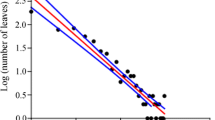Summary
Utricularia vulgaris growing at Wicken Fen, England, showed rapid turnover of the trapping apparatus. New groups of leaves, each bearing many traps, were produced at a rate of 1.4–2.8 groups per day from April to September, 1987. Old leaves decayed at a comparable rate, so that individual leaves survived for less than 50 days. In July, trapping efficiency of individual bladders was greatest between 1 and 6 days of age and then declined rapidly. Very few traps more than 19 days old could capture prey and most were lost from the leaves within 32 days. The lifespan of traps was closely related to their size and position on the leaves. Because of the rapidity of changes in trap condition with age, trap age is a vital consideration in any studies of the functional ecology of U. vulgaris
Similar content being viewed by others
References
Ashida J (1937) Studies on the leaf movement of Aldrovanda vesiculosus L. III Reaction time in relation to temperature. Bot Mag Tokyo 51:505–513
Bazzaz FA, Harper JL (1977) Demographic analysis of the growth of Linum usitatissimum. New Phytol 78:193–208
Beaver R (1983) The communities living in Nepenthes pitcher plants: fauna and food webs. In: Frank JH, Lounibos LP (eds) Phytotelmata: terrestrial plants as hosts for aquatic insect communities. Plexus Publishing Inc, New Jersey, USA, pp 129–159
Fish D, Hall DW (1978) Succession and stratification of aquatic insects inhabiting the leaves of the insectivorous pitcher plant, Sarracenia purpurea. Am Midl Nat 99:172–183
Friday LE (1988) Utricularia vulgaris, an aquatic carnivore at Wicken Fen. Nature in Cambs 30:50–54
Harper JL, Sellek C (1987) The effects of severe mineral nutrient deficiencies on the demography of leaves. Proc Roy Soc London B 232:137–157
Heslop-Harrison Y (1978) Carnivorous plants. Sci Am 238:104–115
Lloyd FE (1942) Carnivorous Plants. Chronica Botanica Co, Waltham, Massachusetts
Lollar AQ, Coleman DC, Boyd CE (1971) Carnivorous pathway of phosphorus uptake by Utricularia inflata. Arch Hydrobiol 69:400–404
Maier R (1973) Produktions-und Pigmentanalysen an Utricularia vulgaris L. im Schilfgürtel des Neusiedler Sees. In: Ellenberg H (ed) Ökosystemforschung. Springer, Berlin Heidelberg New York, pp 87–101
Meyers DG, Strickler JR (1979) Capture enhancement in a carnivorous aquatic plant: function of antennae and bristles in Utricularia vulgaris. Science 203:1022–1025
Sasago A, Sibaoka T (1985) Water extrusion in the trap bladders of Utricularia vulgaris. I. A possible pathway of water across the bladder wall. Bot Mag, Tokyo 98:55–66
Sculthorpe CD (1967) Biology of Aquatic Vascular Plants. Edward Arnold, London
Sydenham PH, Findlay GP (1973) The rapid movement of the bladder of Utricularia sp. Austr J Biol Sci 26:1115–1126
Wallace RL (1977) Substrate discrimination by larvae of the sessile rotifer Ptygura beauchampi Edmondson. Freshw Biol 7:301–309
Weisser P (1970) Die Vegetationsverhältnisse des Neusiedler Sees, pflanzensoziologische und ökologische Studien. Wiss Arb Burgenld 45:1–83
Author information
Authors and Affiliations
Rights and permissions
About this article
Cite this article
Friday, L.E. Rapid turnover of traps in Utricularia vulgaris L.. Oecologia 80, 272–277 (1989). https://doi.org/10.1007/BF00380163
Received:
Issue Date:
DOI: https://doi.org/10.1007/BF00380163




